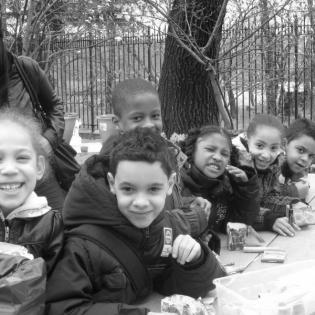The World Outside
Children spend time outside to play in nature and recognize the beauty of diverse living things in their environment. Their service project is to share nature with someone else in a creative interaction.
Students will...
- observe diverse life in nature through all the senses.
- explore creative ways to play outside and build community.
- natural objects to compare in color (flowers, leaves, different branches), texture (rose petals, pine cones, sticks, burrs, leaves), smell (rose petals, herbs, weeds), and taste (herbs, fruits)
Optional:
- beach towels
- a nearby area to observe nature
- blindfolds for each student (can be made out of cloth strips)
To build a love for nature and an understanding of stewardship, encourage young people to be playful and curious in nature. Give them lots of opportunity to get outside, investigate, talk about what they observe, dig in, feel protective, and run around.
- nature: the physical world, including plants, animals, and features of the earth and sky
- natural beauty: existing in nature without chemicals or human interference
- senses: the mechanism through which the body perceives the world, including sight, sound, touch, smell, and taste
- appreciation: enjoyment of the good qualities of something
- What did you observe with your senses? What looks different today than it did yesterday or last month (seasonal changes/human changes to nature)?
- What can we do to enjoy an outdoor space? Who else might enjoy that space?
- How can you help another person feel the beauty and relaxing qualities of nature?
The Curious Garden by Peter Brown
Instructions
Anticipatory Set
Read aloud The Curious Garden by Peter Brown, in which Liam nurtures a garden and transforms a world. Talk about the garden's determination to grow with a little help.
Gather a variety of natural items to observe with their senses. For example, have children close their eyes while you put a pine cone in their hands or rub a rose petal on their cheek. If it is spring, go for a walk and smell different blossoming flowers and trees. Use as many senses as possible to enjoy the natural world. Call attention to spots of nature pushing through human-made spaces.
Discuss our feelings when we observe and interact with diverse things in nature. Bring out their stories of playfulness and beauty outside. Tell about your own experience with a pretty plant, a starry night, a rainbow, or a hike in the woods, if applicable.
Provide art materials for children to draw pictures of themselves plaing outside in nature.
Optional: Take them outside with beach towels and books and allow them the relaxing experience of lying in the grass and reading.
Ask, "What are the reasons to walk and play outside sometimes instead of always inside?" (Lead them to the researched benefits below. Older students may conduct research to find the benefits of being in nature.)
- Makes you healthier
- Makes you happier
- Helps you sleep
- Taking care of nature keeps us alive because nature feeds us and helps us breathe.
Nature provides everything we need from relaxation and wonder to food to housing materials to the weather that impacts our days. Humans need to interact with nature and feel joy. Instead, we stay inside and lose respect for nature. Human separation from nature has created things like pollution, waste, not recycling, and single-use plastic that are hurting nature. People are increasingly disconnected from nature and care less about taking care of it.
Talk about what can we do to make a difference.
- We can play outside more -- alone and with others. We can use our imaginations to enjoy nature together.
- Some nature centers are building mud kitchens outdoors that use only natural utensils -- plates cut out of wood, sticks as tools and utensils, chairs and tables out of wood and rocks.
- We can plant trees and native flowers.
- We can make butterfly and bee garden.
- We can make a birdfeeder from recycled materials.
Project: Plan one thing to do that involves play with nature and includes someone else. Discuss ways to bring someone else into nature to feel happy and healthy. This may be younger children or older: veterans, senior citizens, people with special needs, community centers, libraries, and daycare centers.
You may choose to plan a project with natural toys and games, planting and gardening, hiking in the woods, or cleaning up a park with your community.
Make a plan and carry it out with the service-learning process. This video describes how to plan a project.
Be sure to include other people and spread the word about how much fun it is and the difference it makes in nature.
Philanthropy Framework
-
Strand PHIL.III Philanthropy and the Individual
-
Standard PI 01. Reasons for Individual Philanthropy
-
Benchmark E.1 Describe one reason why a person might give or volunteer.
-
Benchmark E.2 Identify why people practice philanthropy related to their own self-interest.
-
Benchmark E.3 Define stewardship and give examples.
-
Benchmark E.5 Give examples of actions students can take to improve the common good and list or describe responsibilities that go with those actions.
-
-
-
Strand PHIL.IV Volunteering and Service
-
Standard VS 01. Needs Assessment
-
Benchmark E.1 Identify a need in the school, local community, state, nation, or world.
-
-
Standard VS 04. Raising Private Resources
-
Benchmark E.2 Describe a project budget.
-
-
